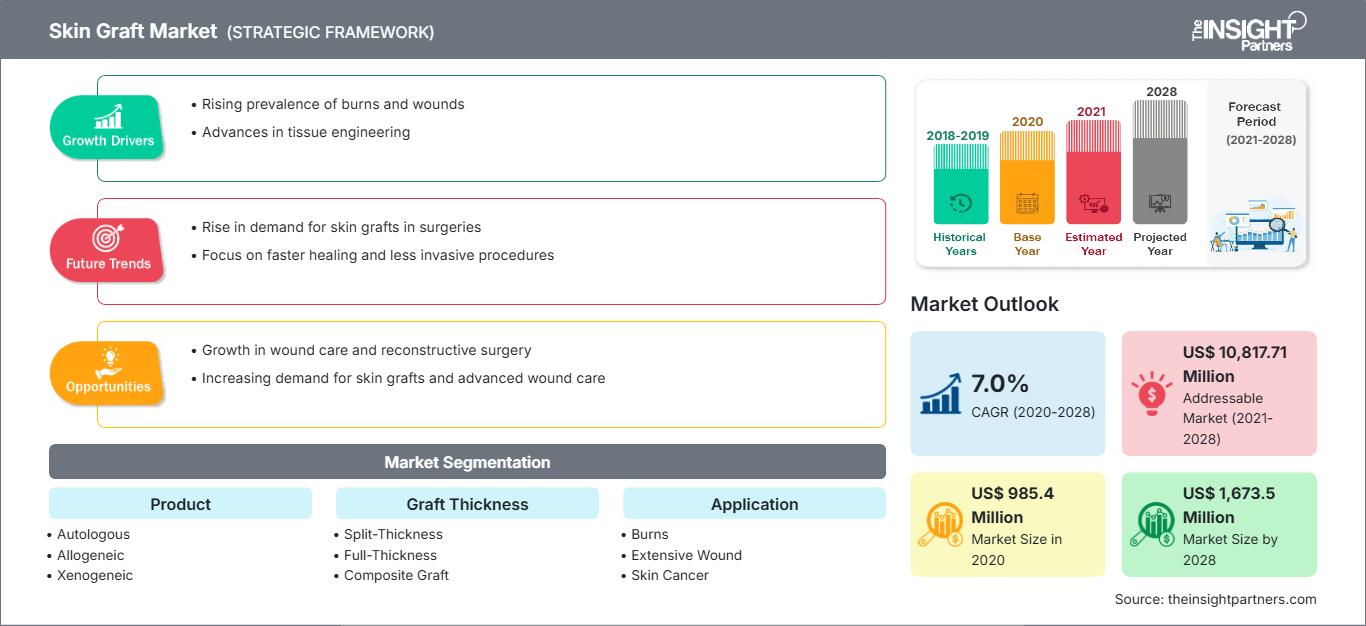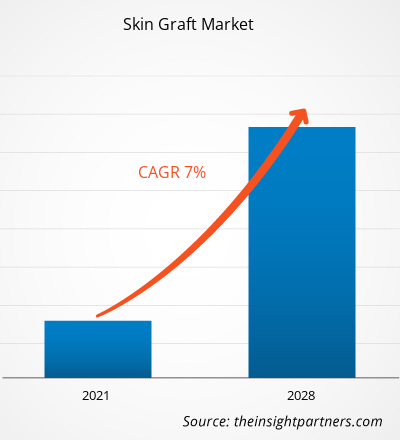Il mercato degli innesti cutanei è stato valutato a 985,4 milioni di dollari nel 2020 e si prevede che raggiungerà i 1.673,5 milioni di dollari entro il 2028; si prevede una crescita a un CAGR del 7,0% dal 2021 al 2028.
L'innesto cutaneo è un intervento chirurgico che prevede il trapianto di pelle utilizzando vari tipi di innesti cutanei. Gli innesti cutanei vengono utilizzati anche per trattare ferite estese, traumi e ustioni. Nella procedura di innesto cutaneo, una piccola porzione di pelle viene prelevata dalla parte del corpo di un paziente e applicata o trapiantata sulla zona interessata, a sua volta prelevata dalla pelle dell'altra parte del corpo del paziente mediante un intervento chirurgico. La porzione di pelle viene trapiantata o applicata sulla parte lesa o ustionata. Il mercato degli innesti cutanei è segmentato in base a prodotto, spessore dell'innesto, applicazione, attrezzatura, utenti finali e regione. Il mercato, in base alla regione, è segmentato in Nord America, Europa, Asia-Pacifico, Medio Oriente e Africa e Sud e Centro America. Il rapporto offre approfondimenti e analisi approfondite del mercato degli innesti cutanei, sottolineando vari parametri, come tendenze di mercato, progressi tecnologici, dinamiche di mercato e analisi del panorama competitivo dei principali attori del mercato in tutto il mondo. Include anche l'impatto della pandemia di COVID-19 sul mercato in tutte le regioni. A causa dello scoppio dell'epidemia di COVID-19, diversi ospedali sono impegnati nel trattamento delle persone infette. Inoltre, diversi centri per la cura delle ferite operano in strutture ospedaliere. Pertanto, la maggior parte dei pazienti non è in grado di ricevere il trattamento per la cura delle ferite. ~ Circa 1 paziente su 4 è in grado di ricevere il trattamento per la cura delle ferite e si prevede che negli Stati Uniti ci siano quasi 6,7 milioni di persone in attesa di trattamento. I ricercatori hanno valutato la stabilità del SARS-CoV-2 e del virus dell'influenza A (IAV), miscelati con terreno di coltura o muco delle vie respiratorie superiori, sulle superfici cutanee umane, e l'efficacia della disinfezione dermica dell'etanolo all'80% (p/p) contro SARS-CoV-2 e IAV. Per evitare di infettare volontari sani, i ricercatori hanno condotto esperimenti di laboratorio utilizzando pelle di cadavere che sarebbe stata altrimenti utilizzata per innesti cutanei. L'epidemia di COVID-19 ha avuto un impatto negativo profondo sul mercato degli innesti cutanei, incidendo negativamente sulla qualità delle cure.
Personalizza questo rapporto in base alle tue esigenze
Potrai personalizzare gratuitamente qualsiasi rapporto, comprese parti di questo rapporto, o analisi a livello di paese, pacchetto dati Excel, oltre a usufruire di grandi offerte e sconti per start-up e università
Mercato degli innesti cutanei: Approfondimenti strategici

-
Ottieni le principali tendenze chiave del mercato di questo rapporto.Questo campione GRATUITO includerà l'analisi dei dati, che vanno dalle tendenze di mercato alle stime e alle previsioni.
Approfondimenti di mercato
Crescente prevalenza di cancro della pelle e diabete
Gli innesti cutanei sono idealmente preferiti dopo l'intervento chirurgico per i tumori della pelle. Gli innesti cutanei vengono generalmente indirizzati alla radioterapia postoperatoria locale (PORT) per garantire la chiusura del letto operatorio creato durante la radioterapia. Secondo Cancer Research UK, nel Regno Unito vengono registrati circa 15.400 nuovi casi di melanoma ogni anno, pari a 42 nuovi casi al giorno. Si prevede che i tassi di incidenza del melanoma nel Regno Unito aumenteranno del 7% tra il 2014 e il 2035, raggiungendo i 32 casi ogni 100.000 persone entro il 2035. Analogamente, secondo le recenti statistiche pubblicate dall'Agenzia Internazionale per la Ricerca sul Cancro, nel 2020 sono stati registrati 19,3 milioni di nuovi casi di cancro, esclusi 18,1 milioni di tumori della pelle non melanoma. Pertanto, è probabile che un aumento della prevalenza del cancro della pelle contribuisca all'innesto cutaneo nel prossimo futuro. Il diabete è tra le condizioni di salute più diffuse in tutto il mondo. Secondo la nona edizione 2019 dell'IDF Diabetes Atlas della International Diabetes Federation (IDF), circa 463 milioni di adulti convivono con il diabete in tutto il mondo. Si stima che la prevalenza raggiungerà i 700 milioni entro il 2045, ovvero quasi il 79% degli adulti con diabete nei paesi a basso e medio reddito in tutto il mondo. Tra la prevalenza del diabete, la percentuale di diabete di tipo 2 sta aumentando a un ritmo molto più rapido. Secondo l'IDF, 374 milioni di persone sono a rischio di sviluppare il diabete di tipo 2 nel prossimo futuro. Tra i pazienti diabetici, la guarigione delle ferite è lenta, il che aumenta il rischio di infezioni cutanee se non guarisce entro un determinato periodo di tempo. È probabile che circa il 25% dei pazienti diabetici sviluppi ulcere del piede almeno una volta nella vita, che spesso richiedono una cura avanzata delle ferite diabetiche. Pertanto, si registra un aumento della domanda di innesti cutanei per trattare o coprire le ulcere del piede diabetico, eliminando il rischio di contrarre infezioni cutanee. Pertanto, si prevede che l'elevata prevalenza di cancro della pelle e diabete guiderà il mercato degli innesti cutanei nel prossimo futuro. Approfondimenti basati sui prodotti In base alla tipologia, il mercato degli innesti cutanei è suddiviso in autologo, allogenico, xenogenico, protesico e isogenico. Il segmento autologo ha rappresentato la quota di mercato più ampia del mercato farmaceutico intermedio globale nel 2020 e si prevede che il mercato dello stesso segmento crescerà più rapidamente e al tasso più elevato tra il 2021 e il 2028. La crescita del mercato del segmento autologo può essere attribuita all'ampio utilizzo di innesti autologhi per il trattamento di ustioni e ferite aperte.
Approfondimenti basati sulle applicazioni
In base all'applicazione, il mercato degli innesti cutanei è segmentato in ustioni, ferite estese, tumori della pelle e altre applicazioni. Il segmento delle ustioni ha detenuto la quota di mercato maggiore nel 2020 e si stima che lo stesso segmento registrerà il CAGR più elevato nel mercato durante il periodo di previsione. Strategie inorganiche come partnership, fusioni e acquisizioni sono comunemente adottate dalle aziende per soddisfare la mutevole domanda dei clienti e mantenere il proprio marchio in tutto il mondo. Gli operatori del mercato che operano nel mercato degli innesti cutanei adottano anche strategie organiche come il lancio e l'espansione di prodotti per ampliare la propria presenza e il proprio portafoglio prodotti a livello mondiale, nonché per soddisfare la crescente domanda.Approfondimenti regionali sul mercato degli innesti cutanei
Le tendenze regionali e i fattori che influenzano il mercato degli innesti cutanei durante il periodo di previsione sono stati ampiamente spiegati dagli analisti di The Insight Partners. Questa sezione illustra anche i segmenti e la geografia del mercato degli innesti cutanei in Nord America, Europa, Asia-Pacifico, Medio Oriente e Africa, America Meridionale e Centrale.
Ambito del rapporto sul mercato degli innesti cutanei
| Attributo del rapporto | Dettagli |
|---|---|
| Dimensioni del mercato in 2020 | US$ 985.4 Million |
| Dimensioni del mercato per 2028 | US$ 1,673.5 Million |
| CAGR globale (2020 - 2028) | 7.0% |
| Dati storici | 2018-2019 |
| Periodo di previsione | 2021-2028 |
| Segmenti coperti |
By Prodotto
|
| Regioni e paesi coperti |
Nord America
|
| Leader di mercato e profili aziendali chiave |
|
Densità degli operatori del mercato degli innesti cutanei: comprendere il suo impatto sulle dinamiche aziendali
Il mercato degli innesti cutanei è in rapida crescita, trainato dalla crescente domanda da parte degli utenti finali, dovuta a fattori quali l'evoluzione delle preferenze dei consumatori, i progressi tecnologici e una maggiore consapevolezza dei benefici del prodotto. Con l'aumento della domanda, le aziende stanno ampliando la propria offerta, innovando per soddisfare le esigenze dei consumatori e sfruttando le tendenze emergenti, alimentando ulteriormente la crescita del mercato.

- Ottieni il Mercato degli innesti cutanei Panoramica dei principali attori chiave
- Autologo
- Allogeneico
- Xenogeneico
- Prostetico
- Isogeneico
Per spessore dell'innesto
- A spessore parziale
- A spessore totale
- Innesto composito
Per applicazione
- Ustioni
- Ferite estese
- Cancro della pelle
- Altre applicazioni
Per attrezzatura
- Dermatomo
- Strumenti chirurgici generali
- Materiali di consumo
- Altri mercati
Per utenti finali
- Ospedali
- Chirurgia ambulatoriale Centri
- Cliniche dermatologiche
Per area geografica
-
Nord America
- Stati Uniti
- Canada
- Messico
-
Europa
- Francia
- Germania
- Italia
- Regno Unito
- Spagna
- Resto d'Europa
-
Asia Pacifico (APAC)
- Cina
- India
- Corea del Sud
- Giappone
- Australia
- Resto dell'APAC
-
Medio Oriente e Africa (MEA)
- Sudafrica
- Arabia Saudita
- Emirati Arabi Uniti
- Resto del MEA
-
America del Sud e Centro (SCAM)
- Brasile
- Argentina
- Resto dello SCAM
Profili aziendali
- B. Braun Melsungen AG
- Integra Life Sciences Corporation
- Smith & Nephew
- AVITA Medical
- MiMedx
- Organogenesis Inc
- Tissue Regenix Group
- Zimmer Biomet
- De Soutter Medical
- Nouvag AG
- Analisi storica (2 anni), anno base, previsione (7 anni) con CAGR
- Analisi PEST e SWOT
- Valore/volume delle dimensioni del mercato - Globale, Regionale, Nazionale
- Industria e panorama competitivo
- Set di dati Excel
Report recenti
Testimonianze
Motivo dell'acquisto
- Processo decisionale informato
- Comprensione delle dinamiche di mercato
- Analisi competitiva
- Analisi dei clienti
- Previsioni di mercato
- Mitigazione del rischio
- Pianificazione strategica
- Giustificazione degli investimenti
- Identificazione dei mercati emergenti
- Miglioramento delle strategie di marketing
- Aumento dell'efficienza operativa
- Allineamento alle tendenze normative






















 Ottieni un campione gratuito per - Mercato degli innesti cutanei
Ottieni un campione gratuito per - Mercato degli innesti cutanei